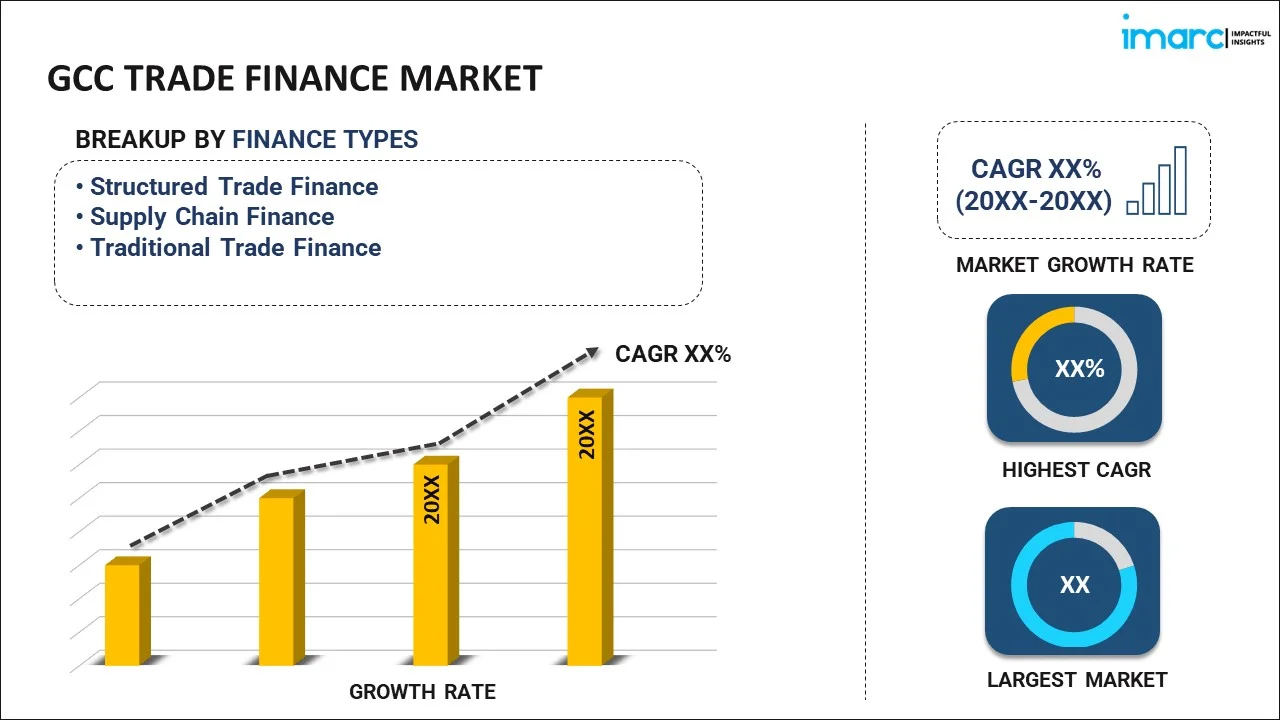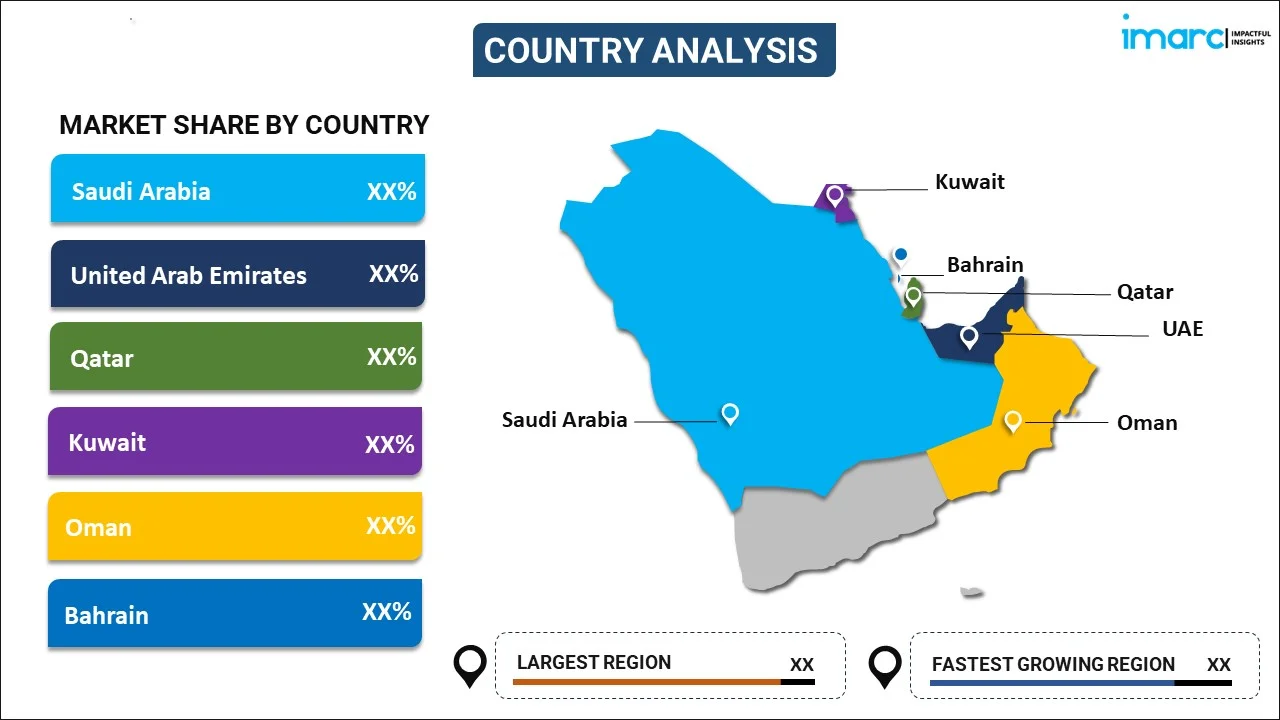
GCC Trade Finance Market Report by Finance Type (Structured Trade Finance, Supply Chain Finance, Traditional Trade Finance), Offering (Letters of Credit, Bill of Lading, Export Factoring, Insurance, and Others), Service Provider (Banks, Trade Finance Houses), End User (Small and Medium Sized Enterprise (SMEs), Large Enterprises), and Country 2025-2033
Market Overview:
The GCC trade finance market size reached USD 1.0 Billion in 2024. Looking forward, IMARC Group expects the market to reach USD 2.0 Billion by 2033, exhibiting a growth rate (CAGR) of 7.3% during 2025-2033. The growing economic diversification, favorable government initiatives and policies, rapid technological innovations, ongoing investment in infrastructure and the rising small and medium-sized enterprises (SMEs) represent some of the key factors driving the market.
|
Report Attribute
|
Key Statistics
|
|---|---|
|
Base Year
|
2024
|
|
Forecast Years
|
2025-2033
|
|
Historical Years
|
2019-2024
|
|
Market Size in 2024
|
USD 1.0 Billion |
|
Market Forecast in 2033
|
USD 2.0 Billion |
| Market Growth Rate 2025-2033 | 7.3% |
Trade finance is a vital component in international trade that drives transactions and fosters business growth. It encompasses various financial instruments and products designed to facilitate the buying, selling, and trading goods and services. Trade finance involves letters of credit (LCs), trade credit, export and import financing, and more. It involves banking institutions, exporters, importers, and various intermediaries working together to establish terms and conditions and provide funding. Trade finance has extensive applications in automotive, technology, healthcare, energy, retail, transportation, manufacturing, construction, agriculture, hospitality, and others. It enhances global economic development, provides working capital, minimizes risk, ensures payment security, promotes international trade relationships, and aids in regulatory compliance. It offers several advantages, including financial flexibility, streamlined processes, reduced trade barriers, improved efficiency, support in managing currency fluctuations, fostering business expansion, and creating opportunities for small and medium-sized enterprises (SMEs).
GCC Trade Finance Market Trends/Drivers:
The growing economic diversification in the region leading to increased trade activities and the need for robust trade finance solutions are major factors driving the market growth. Additionally, the implementation of various government initiatives and policies to promote international trade, encouraging the use of trade finance instruments is providing a considerable boost to the market growth. In line with this, rapid technological advancements into trade finance simplifying processes, enhancing security, and attracting more businesses is creating a positive outlook for the market growth. Moreover, the increasing global trade relations in the region with international markets is supporting the market growth. In addition to this, the growing banking and financial sectors within the region providing a solid foundation for trade finance is positively impacting the market growth. In confluence with this, ongoing investments in infrastructure promoting industrial growth is providing a thrust to the market growth. Besides this, the growing application of financial trade by small and medium enterprises (SME) sector to expand and to engage in global trade is creating a positive outlook for the market growth. Furthermore, the increasing focus on sustainable and ethical trading practices by socially responsible businesses is favoring the market growth. In addition to this, the increasing popularity of digitalization, fintech integration, and innovative financial products are fueling the market growth. Moreover, the advent of blockchain and artificial intelligence (AI) in trade finance paving the way for more transparent and efficient transactions is propelling the market growth. In confluence with this, the increasing collaborations between traditional banks and fintech firms spurring innovation, is providing an impetus for the market growth.
GCC Trade Finance Industry Segmentation:
IMARC Group provides an analysis of the key trends in each segment of the GCC trade finance market report, along with forecasts at the regional and country levels for 2025-2033. Our report has categorized the market based on finance type, offering, service provider and end user.
Breakup by Finance Type:

- Structured Trade Finance
- Supply Chain Finance
- Traditional Trade Finance
The report has provided a detailed breakup and analysis of the market based on the finance type. This includes structured trade finance, supply chain finance and traditional trade finance.
Breakup by Offering:
- Letters of Credit
- Bill of Lading
- Export Factoring
- Insurance
- Others
A detailed breakup and analysis of the market based on the offering has also been provided in the report. This includes letters of credit, bill of lading, export factoring, insurance, and others.
Breakup by Service Provider:
- Banks
- Trade Finance Houses
A detailed breakup and analysis of the market based on the service provider has also been provided in the report. This includes banks and trade finance houses.
Breakup by End User:
- Small and Medium Sized Enterprise (SMEs)
- Large Enterprises
A detailed breakup and analysis of the market based on the end user has also been provided in the report. This includes small and medium sized enterprises (SMEs) and large enterprises.
Breakup by Country:

- Saudi Arabia
- UAE
- Qatar
- Bahrain
- Kuwait
- Oman
The report has also provided a comprehensive analysis of all the major regional markets, which include Saudi Arabia, the UAE, Qatar, Bahrain, Kuwait, and Oman.
Competitive Landscape:
The report has also provided a comprehensive analysis of the competitive landscape in the market. Competitive analysis such as market structure, key player positioning, top winning strategies, competitive dashboard, and company evaluation quadrant has been covered in the report. Also, detailed profiles of all major companies have been provided.
GCC Trade Finance Market Report Scope:
| Report Features | Details |
|---|---|
| Base Year of the Analysis | 2024 |
| Historical Period | 2019-2024 |
| Forecast Period | 2025-2033 |
| Units | Billion USD |
| Scope of the Report | Exploration of Historical and Forecast Trends, Industry Catalysts and Challenges, Segment-Wise Historical and Predictive Market Assessment:
|
| Finance Types Covered | Structured Trade Finance, Supply Chain Finance, Traditional Trade Finance |
| Offerings Covered | Letters of Credit, Bill of Lading, Export Factoring, Insurance, Others |
| Service Providers Covered | Banks, Trade Finance Houses |
| End Users Covered | Small and Medium Sized Enterprise (SMEs), Large Enterprises |
| Countries Covered | Saudi Arabia, UAE, Qatar, Bahrain, Kuwait, Oman |
| Customization Scope | 10% Free Customization |
| Post-Sale Analyst Support | 10-12 Weeks |
| Delivery Format | PDF and Excel through Email (We can also provide the editable version of the report in PPT/Word format on special request) |
Key Questions Answered in This Report:
- How has the GCC trade finance market performed so far and how will it perform in the coming years?
- What has been the impact of COVID-19 on the GCC trade finance market?
- What is the breakup of the GCC trade finance market on the basis of finance type?
- What is the breakup of the GCC trade finance market on the basis of offering?
- What is the breakup of the GCC trade finance market on the basis of service provider?
- What is the breakup of the GCC trade finance market on the basis of end-user?
- What are the various stages in the value chain of the GCC trade finance market?
- What are the key driving factors and challenges in the GCC trade finance market?
- What is the structure of the GCC trade finance market and who are the key players?
- What is the degree of competition in the GCC trade finance market?
Key Benefits for Stakeholders:
- IMARC’s report offers a comprehensive quantitative analysis of various market segments, historical and current market trends, market forecasts, and dynamics of the GCC trade finance market from 2019-2033.
- The research study provides the latest information on the market drivers, challenges, and opportunities in the GCC trade finance market.
- Porter's five forces analysis assist stakeholders in assessing the impact of new entrants, competitive rivalry, supplier power, buyer power, and the threat of substitution. It helps stakeholders to analyze the level of competition within the GCC trade finance industry and its attractiveness.
- Competitive landscape allows stakeholders to understand their competitive environment and provides an insight into the current positions of key players in the market.
Need more help?
- Speak to our experienced analysts for insights on the current market scenarios.
- Include additional segments and countries to customize the report as per your requirement.
- Gain an unparalleled competitive advantage in your domain by understanding how to utilize the report and positively impacting your operations and revenue.
- For further assistance, please connect with our analysts.
 Inquire Before Buying
Inquire Before Buying
 Speak to an Analyst
Speak to an Analyst
 Request Brochure
Request Brochure
 Request Customization
Request Customization




.webp)




.webp)












